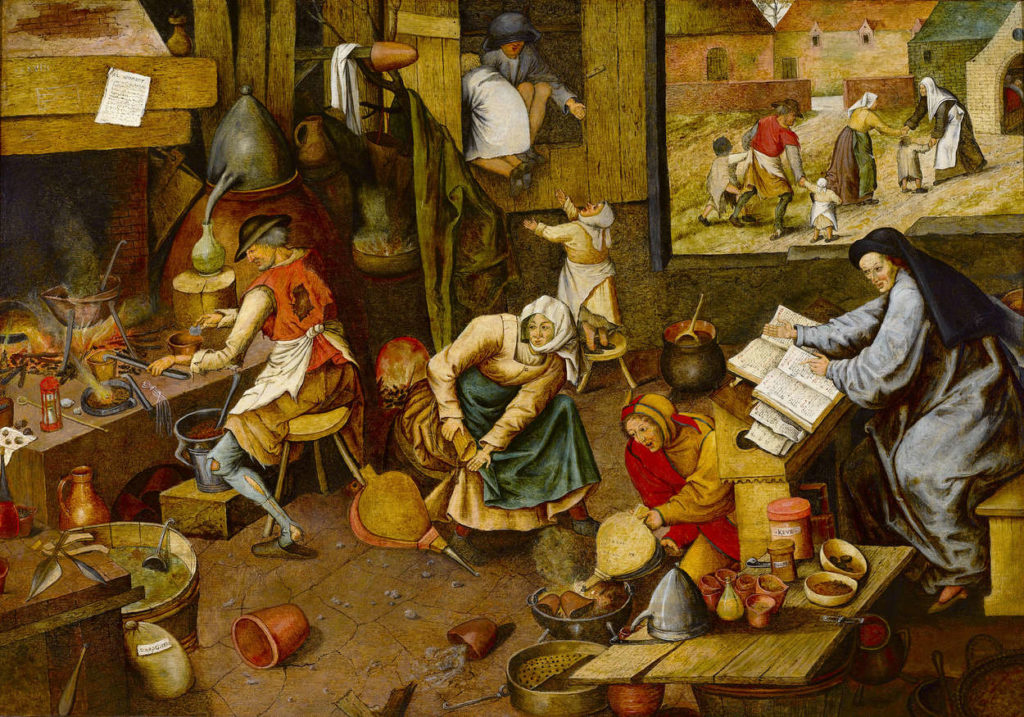Much of our collective memory and history is rooted in storytelling, and it is an art form unique to the human experience. How we tell these tales can vary, from oral poetry to literature to song to art, and we have created tools to aid us in conveying their meaning. One of the most effective of these tools is allegory. Using symbol and metaphor, an allegory is a story with a hidden significance used to deliver a deeper message, and, in fact, comes from the Latin allegoria meaning “veiled language”. But when the veil is pulled back, what is revealed? Allegories are a comprehensible way to express complex, abstract ideas such as love, life, death, virtue and justice. In other words, an allegory is a neatly packaged idea or lesson, ready to reveal itself, and only waiting to be unwrapped and examined by us.
The visual nature of painting on canvas lends itself well to an allegorical approach because an image allows for conciseness in the telling of a story and accessibility for the viewer. Read on for a few examples of allegory paintings from our collection.
Mythological Traditions
Classical mythology seems a fitting place to begin, as the origins of allegory go back to the great minds of ancient Greece and Rome, such as Homer with his use of personifications in the Iliad and Plato's famous Allegory of the Cave.
One of the greatest legends in mythology is the story of Achilles. As a boy, he was sent to Mount Pelion to be raised by Chiron the Centaur. Chiron was so knowledgeable about natural law, healing, music and hunting that his wisdom was sought after by all of the most heroic figures of mythology, including Perseus, Hercules, and, of course, Achilles. In August-Clément Chrétien's depiction of this story, The Education of Achilles, Chiron embodies the concept of Teacher as a commanding but nurturing presence correcting his young pupil's grasp of his bow and arrow.
In mythology, there is often more to the story than meets the eye. Trickery and disguise abound. Allegorical art can build on this to create an extended metaphor that offers the viewer more to discover. In the story of Leda and the Swan, Zeus, king of the gods, transforms himself into a swan in order to seduce the beautiful mortal, Leda. In Jean-Léon Gérôme's version of this myth painted in 1896, Leda, soft and welcoming, is a stand-in for sensuality itself. As a master of capturing the female figure nude, Gérôme uses this tale and its elements to his advantage, depicting both Leda and the swan as personifications of beauty and desire.
Biblical Parables
The Bible is a rich resource for artists, and its stories have been popular subjects in art for centuries. This symbolic allegorical painting by the Flemish Old Master, Pieter Lisaert, entitled The Parable of the Wise and Foolish Virgins depicts one of Jesus's most well-known parables. The painting's subject matter is taken from the book of Matthew, chapter 25, verses 1-13, which tells the story of ten maidens invited to a wedding by the bridegroom. In this artwork, each has a lamp that they are tasked with keeping lit through the night until the bridegroom comes to retrieve them and bring them to the wedding. The five wise virgins in the foreground of the scene have extra oil to keep their lamps' flames alive and they occupy themselves with virtuous tasks while they wait. The five foolish virgins, having brought no extra supplies, can be seen in the background frolicking, willfully ignorant of the consequences of not being prepared. As the story goes, when the groom returns, the foolish virgins miss him and are not led back to the festivities.
This symbolic imagery conveys God's promise of the second coming of Christ and instructs the viewer to remain vigilant, pious and ever-prepared because, according to the Bible, one can not know the day and the hour of his return. Lisaert's careful composition further emphasizes this lesson. The wise virgins are grounded in the forefront of the scene and gather at the base of a large tree, firmly planted and steady, echoing the tree's roots. In contrast, the foolish virgins teeter on the edge of the marble hillside out of our reach, delivering a powerful hidden message that is both genius and creative.
Genre Scenes
Pieter Brueghel the Younger painted many of the finest examples of extended metaphor in art. As in our previous example, the painter seeks to instruct the viewer in his artwork. However, in his masterpiece, The Alchemist, Brughel warns us not only of the dangers of folly, but also greed.
Here we see an alchemist frantically at work in his attempt to conjure up gold, surrounded by his wife, a scholar, and a fool, all aiding him in this futile and arrogant exercise. By the time this genre scene was painted in the 17th century, the practice of alchemy - to transform one metal into another - had been completely discredited. This artwork would have been a clear message to viewers at the time to beware of being tempted by the promise of something unearned. Brueghel skillfully communicates the consequences of falling victim to this temptation through intricate details such as the alchemist's blind focus on the lie in front of him, his wife's desperate search for more coins in her purse, and the fool's mad fanning of the flame.
Brueghel also reveals the ultimate consequence of this absurd endeavor in the upper right hand corner of the panel. In the fateful conclusion of the alchemist's work, his family is reduced to begging from the poor house. As with all allegorical paintings with a hidden meaning, Brueghel leaves his viewer with a clear message to contemplate: Folly leads to ruin.










